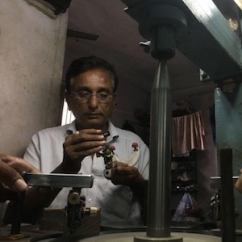Articles and News
Reuters Exposes Poor Working Conditions And Rising Suicides In Indian Diamond Factories | July 11, 2018 (1 comment)

Surat, India—A spate of suicides among laborers in India’s diamond cutting factories has caught the attention of a major international news agency. Reporters from the Thomson Reuters Foundation on Tuesday released a lengthy article detailing low wages and sometimes harsh labor conditions in some diamond polishing facilities in Surat, India’s largest cutting center. (Left: a diamond cutter examines a stone at a small factory in Surat. Image, Reuters.)
That’s not good news on any front, but especially not for an industry already sporting a permanent black eye over conflict diamonds.
Reporters followed the trail of almost two dozen recent diamond worker suicides, but the article points out that this isn’t a new phenomenon. During the 2008 global recession—which hit the diamond industry hard and resulted in many layoffs—there were anywhere from 50 to 300 suicides of diamond workers, depending on whose figures are cited.
Reuters says the large, well-known diamond companies typically have state-of-the-art factories with air conditioning, modern plumbing, and fixed wages. But many smaller or more remote cutting shops don’t—and workers often eat, sleep, and work in slave-like conditions with no ventilation or toilets. And they’re paid by the piece, not a fixed wage.
The big three mining companies—De Beers, Rio Tinto, and Alrosa—all say the companies they sell rough diamonds to treat their workers well. Likewise, so does Canadian miner Lucara and the giant Asian retailer Chow Tai Fook, which buys massive quantities of diamonds from India. Indeed, for all five companies, fair wages, good working conditions, and worker benefits are part of the requirement companies must meet to do business with them.
The biggest issue leading to worker suicides seems to be loans, debts, and layoffs, Reuters found. Workers who commit suicide often have taken out loans that they later can’t repay when work slows down and their wages are cut or even at times delayed during slow periods. But families often don’t complain because diamond-cutting work comes through a network of connections—and there may not be much of an option for other work for some of the cutters who dropped out of school.
Although the industry has the Kimberley Process in place to prevent the entry of conflict diamonds into the supply chain, there’s no similar chain to protect workers from exploitation. The closest option is the Responsible Jewellery Council (RJC), the industry’s global nonprofit standards and certification organization. Based in London, it has more than 1,100 member companies, according to its website, spanning the jewelry supply chain from mine to retail. But membership in the RJC is voluntary, not mandatory, which means plenty of operators that don’t follow the same standards.
Related: The Rise And Rise Of The Ethical Jewelry Designer
“Today’s increasingly conscientious consumer, and retailers on the forefront, have prompted much of the jewelry industry to ensure operations are as transparent as possible. Clearly, having a tangible and ethical approach to business speaks to the concerns of these key audiences,” says Gerhard de Meyer, communications director of RJC.
“The RJC’s Code of Practices (COP) and Chain of Custody (CoC) are the industry-recognized standards for supply chain integrity and sustainable business practices. By implementing them, businesses are openly stating their ongoing commitment to ethical business practices,” he told The Centurion. Engaging with RJC members gives assurance that these businesses are taking all necessary steps to reduce supply chain risk. They have identified and mitigated vulnerabilities and, where necessary, improved their business operations. The security is something that is passed on to customers, whether that be a consumer in-store or a manufacturer purchasing materials.”
The Reuters report also comes as the natural diamond industry is grappling with the rapid advancement of synthetic diamonds. Synthetic diamond growers have already grabbed the blood diamond narrative as a selling point for their product, but their diamonds must be cut somewhere too—and poor working conditions in diamond cutting factories could become just as much of a hot mess for them as for the natural diamond industry if it goes viral.
But that’s small consolation when the entire fine jewelry industry is struggling with a tenuous grasp on Millennials, a highly socially-conscious group. Luckily, there are proactive steps retailers can take to ensure they’re not caught unaware if this blows up into another storm of bad press a la conflict diamonds.
The simplest step is to commit to doing business only with firms that are transparent about their labor practices and/or who are members of third-party organizations that will certify their practices as ethical, such as the Responsible Jewellery Council. Retailers themselves also can join the RJC; see information here. Joining industry organizations like the Jewelers’ Vigilance Committee (JVC), American Gem Society, Jewelers of America, and other groups, also provides consumers with reassurance that the jeweler is committed to ethical business practices.
With Fair Trade organizations becoming ubiquitous across product categories, at some point—sooner than later—getting such a certification is going to become a necessary part of doing business for jewelers. As the industry learned the hard way with conflict diamonds, it’s better to be in front of the trend than behind it.







